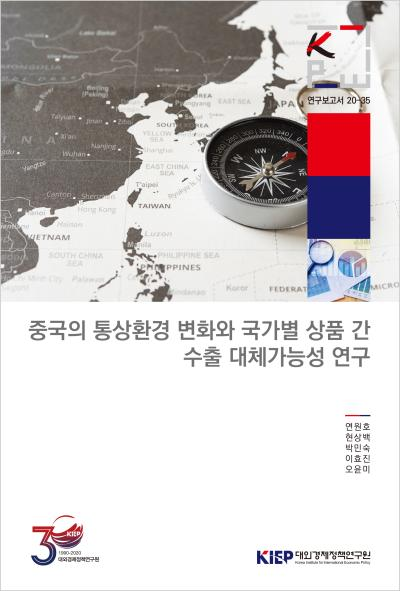Policy Analyses
PUBLISH
Policy Analyses
To list

Multidimensional Substitutability Measurement and Analysis: with an Application to Trade between China and South Korea
Economic relations, Trade structure
Author Wonho Yeon, Sangbaek Hyun, Minsuk Park, Hyojin Lee, and Yunmi Oh Series 20-35 Language Korean Date 2021.05.28
Recent changes in the trade environment surrounding China are developing dynamically. These changes are expected to directly or indirectly affect the Korea-China trade structure. Therefore, in this study, focusing on the possibility that Korea’s exports to China could be replaced by Chinese or foreign products in the future, we establish a new quantitative analysis methodology to analyze the level of substitutability of Korean exports.
One of the most important external changes in China’s trade environment is the U.S.-China trade conflict. In particular, in countries such as Korea that export final products to the U.S. while forming a division of labor with China in the global value chain (GVC), the conflict between the U.S. and China is acting as a greater destabilizing factor. In terms of the substitutability of Korean exports to China, the U.S.-China conflict can have an effect through various channels, and one of the important events is the U.S.-China Phase 1 trade agreement.
For internal changes, it is important to study China’s industrial upgrading strategy. China, which has been called the “world’s factory,” has been pursuing a strategy to improve the localization rate and upgrade its industrial structure through technological development and innovation. Accordingly, China has been adjusting its role and position within the GVC, in which China used to be in charge of the simple processing trade. As the U.S.-China trade dispute escalated since 2018, the U.S. containment policies have intensified as well, particularly against China’s advanced industry and technology sector. As a reaction to this, China has dealt with its industrial policies not only in the context of economic growth but also in national security. The strategy to indigenize core technologies and parts has been strengthened and pursued under the goal of establishing a fully independent supply chain within the nation. Due to China’s industrial advancement and import substitution strategy, concerns are growing about the replacement of Korean-made exports to China by Chinese products.
In Chapter 2, the internal and external factors of the recent development of China’s trade environment are briefed. As an external factor, the US-China Phase 1 trade agreement was reviewed, and as an internal factor, the import substitution strategy of China was examined. Chapter 2 provides the background of the case analysis in Chapter 4, while emphasizing the necessity for developing the new multidimensional methodology that was newly modeled in Chapter 3.
In Chapter 3, we explained the multidimensional import substitution index model, which is the core contribution of this study. First, we examined the Alkire-Foster (AF) model that provides the basic structure for the Yang-Yeon (YY) model that derives the multidimensional substitutability index (MSI). Second, we explained our model, the Yang-Yeon (YY) model, which is a newly built methodology based on the AF model to analyze the probability of substitution between the imported products.
In Chapter 4, applying the YY model derived in Chapter 3, we conducted case studies to see how Korea’s exports to China are actually affected by related events and policies. First, we analyzed the effect of the U.S.-China Phase 1 trade agreement on Korea’s exports to China. Second, we investigated the influence of China's import substitution policies on Korea’s exports to China.
In the last chapter, we reemphasized the necessity of the YY model to fully understand the substitutability between the exporting goods and the trade partner’s home-produced goods or the third party’s exporting goods. Also summarizing the analysis results of the case studies based on the YY model, we presented the policy implications and suggestions. The YY model predicted that the US-China Phase 1 trade agreement would not have a significant impact on Korea’s exports to China. This suggests that it is necessary to prepare more objective and comprehensive responses using quantitative methods such as the Multidimensional Substitutability Index (MSI) rather than engaging in qualitative conjecture or groundless concerns. However, the YY model predicted that China’s industrial upgrading policy would act as a major threat to Korea’s exports to China in the long term. In particular, the possibility of Chinese goods replacing Korean products is high in general goods, suggesting that Korean-made products with low technological levels will eventually be replaced by the Chinese as Chinese manufacturing technologies advance. What is more worrisome is that Chinese industries and products positioned as strategic emerging industries or targets of scientific and technological innovation, such as products related to renewable energy, batteries, semiconductors, and electric vehicles, are highly expected to replace Korean products not only in the mid- to long-term but also in the short term.
Korea’s best response to China’s industrial upgrading strategy will be to maintain its comparative advantages over China. However, the realities in Korea make it difficult to maintain competitiveness in all industries and technologies, meaning it will be necessary to choose and focus on areas that will develop as major industries in the era of the 4th industrial revolution. Therefore, we hope the newly constructed YY model that provides the Multidimensional Substitution Index (MSI) will help policymakers to identify areas where competition with China is likely to intensify, and to determine the target and priority of policy support.
Sales Info
| Quantity/Size | 178 |
|---|---|
| Sale Price | 7 $ |
 공공저작물 자유이용허락 표시기준 (공공누리, KOGL) 제4유형
공공저작물 자유이용허락 표시기준 (공공누리, KOGL) 제4유형
대외경제정책연구원의 본 공공저작물은 "공공누리 제4유형 : 출처표시 + 상업적 금지 + 변경금지” 조건에 따라 이용할 수 있습니다. 저작권정책 참조
